
 |
State Spending Plan for 1996-97
|
Figure 6 describes the major General Fund changes enacted in the 1996 Budget Act and related legislation. As the figure shows, the largest savings result from continuing grant reductions previously enacted on a temporary basis in the Supplemental Security Income/State Supplementary Program (SSI/SSP) ($487 million) and in the AFDC Program ($199 million).
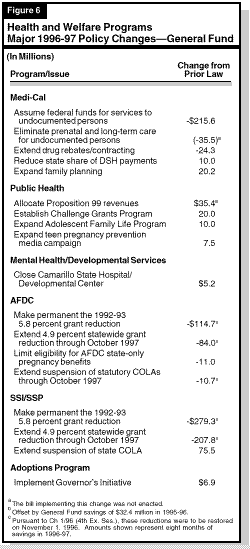
v Whether the state elects to backfill for reductions in federal funds.
Potential major impacts on state spending in 1996-97 include:
Federal Funds for Services to Illegal Immigrants. The budget assumes receipt of $216 million in federal funds to partially offset state costs for emergency health services provided to illegal immigrants. Funding for this purpose is authorized by federal immigration reform legislation, but was not appropriated in the 1997 budget measure.
Prenatal and Long-Term Care for Illegal Immigrants. The budget assumed adoption of the Governor's proposal to eliminate prenatal benefits and long-term care (new applicants only) for illegal immigrants, beginning January 1, 1997, for a General Fund savings of $34.7 million and $856,000, respectively. However, implementing state legislation was not enacted, and consequently these savings are not reflected in the estimated budget spending totals for 1996-97. The recently enacted federal welfare reform legislation, however, includes a provision that prohibits states from providing most types of benefits to illegal immigrants unless state legislation is enacted subsequent to the federal law. This federal legislation also may be a factor in the court's consideration of the case dealing with the state's implementation of restrictions on benefits for illegal immigrants in Proposition 187. (This measure was approved in 1994 but currently is enjoined by the courts.) For these reasons, the status of these programs and any potential savings from their elimination are uncertain at this time.
Supplemental Drug Rebates and Drug Contracting. Budget-related legislation (AB 3483, Friedman) extends the Supplemental Drug Rebate program for six monthsthrough December 31, 1996for a General Fund savings of $17.3 million. This program requires drug manufacturers to provide a 10 percent rebate to the Medi-Cal Program for drugs that may be prescribed without prior approval by the state. The budget legislation also extends, for two years, the authority for the department to negotiate drug rebates with individual pharmaceutical manufacturers. The budget assumes savings of $7 million in 1996-97 due to the extension of this program.
Disproportionate Share Hospital (DSH)
Payments. The budget includes a $10 million General Fund augmentation to
backfill for
a reduction in the amount of DSH funds retained by the state to
help finance the Medi-Cal Program. Pursuant to budget legislation
(AB 3484, Friedman and Granlund) this change will result in
an equivalent increase in DSH payments to county and other
public hospitals. The DSH payments are a means of allocating
supplemental federal Medicaid funds to hospitals that care for a relatively
large number of low-income persons.
Family Planning Program. The budget includes a $20.2 million General Fund augmentation to support the Governor's proposal to expand family planning services. Beginning January 1, 1997, budget legislation (AB 3483, Friedman) consolidates the existing non-Medi-Cal family planning program with the Medi-Cal Program to create a new entitlement program for persons with family incomes at or below 200 percent of the federal poverty level. The new program sunsets July 1, 2000, and if not extended, the previous program will be reinstated.
Proposition 99. Proposition 99, approved in 1988, established a surtax on cigarettes and tobacco products and allocates the surtax revenues to six accounts for a variety of purposes, including tobacco-related education and research, indigent health care, and habitat conservation. Some of these Proposition 99 funds help to finance programs that also receive General Fund support. The Legislature adopted the Governor's proposal for 1995-96, which allocated revenues to the various accounts in accordance with the percentages specified in Proposition 99. This resulted in General Fund savings of $32.4 million.
For 1996-97, however, the Legislature rejected the Governor's proposal to change the distribution of Proposition 99 revenues among the six accounts, which would have required a four-fifths vote of the Legislature. Instead, the budget and related implementing legislation (AB 3487, Katz and Pringle) provides for distributing the revenues consistent with the provisions of Proposition 99.
Under the budget plan for 1996-97, spending will increase
significantly for (1) health education programs administered through
the Departments of Education and Health Services, including $5
million earmarked for smoking cessation classes, and (2) smoking-
and tobacco-related research by the UC. Compared with the
Governor's proposal, the budget plan increases General Fund costs by
$35.4 million in 1996-97.
Teen Pregnancy Prevention and Teen
Parenting. Budget legislation (AB 3483, Friedman) enacted, in part, the Gov
ernor's proposal
to expand teen pregnancy prevention programs. The budget
provides $7.5 million to expand the media campaign and $20
million to establish a new Challenge Grants program to fund local
teen pregnancy prevention projects. The budget also appropriates
$10 million to expand the Adolescent Family Life Program,
which provides case management and other support services for
pregnant and parenting teens.
Grant Reductions. Budget legislation (SB 1780, Committee on
Budget and Fiscal Review) extends through October 1997 the 4.9
percent statewide grant reduction of 1995-96 and makes permanent the
5.8 percent grant reduction of 1992-93. This results in
combined General Fund cost avoidance and savings of $199 million in
1996-97. Implementation of the 4.9 percent statewide grant reduction in
1996-97 depends on early state implementation of the new federal
TANF block grant, which will replace AFDC under recent federal
welfare reform legislation, or on federal approval of a pending
waiver request submitted under the AFDC program. (These conditions
also apply to an additional 4.9 percent grant reduction in
low-rental-cost counties, enacted on a permanent basis in 1995-96.) The
budget anticipates that the maximum monthly grant for a family of
three will be reduced from $594 to $565 in high-cost counties and to
$538 in low-cost counties (see Figure 7).
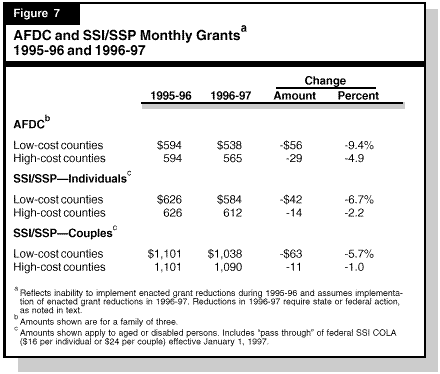
Cost-of-Living Adjustment. The budget extends the suspension of the COLAs for AFDC grants, and AFDC Foster Care group home rates, through October 1997. This results in General Fund savings of $10.1 million in AFDC grants and $0.6 million in Foster Care payments.
Pregnancy Benefits. Budget legislation (SB 1780) limits eligibility
for state-only AFDC pregnancy benefits to recipients who are
eligible for the Cal Learn Program (teen parents who have not
graduated from high school). This results in General Fund savings of
$11 million in 1996-97.
Grant Reductions. Budget legislation (SB 1780) extends through October 1997 the 4.9 percent statewide grant reduction of 1995-96 and makes permanent the 5.8 percent grant reduction of 1992-93. This results in combined General Fund cost avoidance and savings of $487 million in 1996-97. The maximum monthly grant for aged and disabled individuals (the largest category of recipients) would be reduced, in November 1996, from $626 to $596 in high-cost counties and to $568 in low-cost counties. Subsequently, recipients will receive a federal COLA in January 1997, amounting to $16 for individuals (see Figure 7).
Implementation of the statewide 4.9 percent grant reduction
($208 million savings) is contingent upon federal legislation.
Federal legislation also is necessary to implement an additional 4.9
percent grant reduction in low-rental-cost counties, which was enacted on
a permanent basis in 1995-96. Together, these grant reductions
account for $268 million of net budgeted savings in 1996-97. The budget
assumed that federal welfare reform legislation would authorize
these reductions, but this provision was not included in the recently
enacted federal welfare reform legislation. As a result, these savings are at risk.
State COLA. Budget legislation extends the suspension of the state COLA for one year. Prior law would have resumed the state COLA, whichbecause of the interaction with the federal COLAwould have resulted in a state savings. Thus, by not providing the state COLA, the budget legislation results in a General Fund cost of $75.5 million, compared to prior law. As noted above, however, recipients will receive the full federal SSI COLA on their grants.
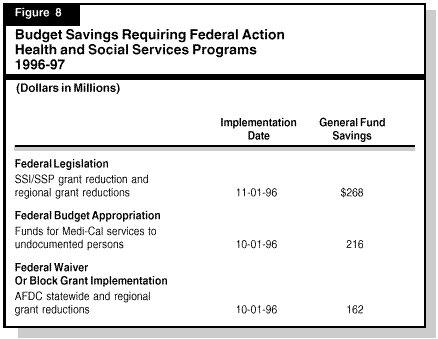
The total amount is about $186 million below the Governor's January Budget. The principal reason for the change is revised downward estimates of the prison inmate population contained in the May Revision.
The major changes in the 1996 Budget Act relative to the Governor's Budget are discussed below and summarized in Figure 9.
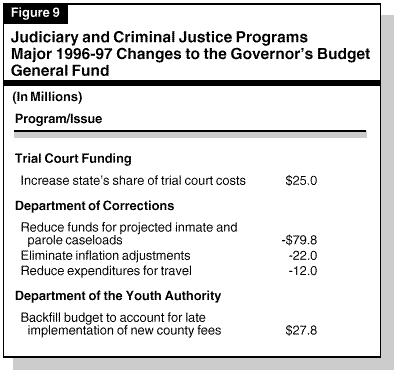
The measure would have generated about $91 million in additional revenues from court-related fees, which were appropriated in the Budget Act. As a result of the failure of AB 2553, however, this additional revenue will not be available for expenditure (presumably the counties, which provide the bulk of financial support for trial courts, will have to make up the difference, or the trial courts will have to reduce their budgets). In addition, the failure to enact AB 2553 will result in the need for follow-up legislation to make technical adjustments to the Budget Act appropriation for trial court funding.
The budget includes $2 million to support 21 new trial court judgeships beginning in the last quarter of 1996-97. The new judgeships were established pursuant to Ch 262/96 (AB 1818, Baca).
The budget provides a total of $3.5 billion from the General Fund for support of the California Department of Corrections (CDC). This represents an increase of about 8 percent above the 1995-96 level and is primarily due to projected increases in inmate and parole populations.
The budget reflects a reduction of about $57.8 million below the January request as a result of caseload changes contained in the May Revision. The most significant changes made by the Legislature were an additional reduction in funds requested for inmate population changes to reflect more recent trends ($22 million), elimination of funds for inflation adjustments ($22 million), and reduction in funds requested for travel ($12 million).
Inmate Caseloads. The Legislature considered a number of changes that would have saved money by reducing the number or length of stay of offenders in prison and on parole. None of these changes were included in the final budget, however. The budget assumes that the prison inmate population will reach about 156,000 inmates by June 30, 1997, an increase of approximately 9.5 percent over 1995-96.
Federal Funds for Incarceration and Supervision of Undocumented Felons. The budget assumes a total of about $514 million in federal funds to offset the state's costs of supervising undocumented inmates and wards in state prison and the Department of the Youth Authority in 1995-96 and 1996-97. This amount is about $87 million less than the amount assumed in the Governor's January budget proposal for the two-year period and is consistent with estimates of California's share of existing federal appropriations and authorizations.
Delay in Implementation of New County Fees. The amount included in the Budget Act for the Youth Authority is about $24 million more than the level requested in the Governor's January budget proposal. The principal reason for this increase is that the January budget assumed that legislation would be enacted and take effect on February 1, 1996, to increase the fees that counties pay the state for commitment of juvenile offenders to the Youth Authority; however, the new fees will not take effect until January 1, 1997. Thus, the Legislature augmented the budget for the Youth Authority to account for the state receiving less fee revenues than originally anticipated from counties.
"M Case" Transfer. In addition, the budget anticipates transferring from the Youth Authority to the CDC custody of "M cases" who are 18 years of age or older, pursuant to a budget trailer bill (Ch 195/96 [AB 3369, Bordonaro and Wright]). ("M cases" are offenders who are sentenced to the CDC, but who are transferred to the Youth Authority to serve all or part of their incarceration time.) Because the costs of housing offenders in the CDC is less than the costs of the Youth Authority, the budget anticipates net savings of $2.1 million in 1996-97.
Assistance for Direct Law Enforcement. In his January budget, the Governor proposed $150 million of state funds for local law enforcement under the Citizens' Option for Public Safety (COPS) program. Specifically, the Governor proposed to modify the state's personal income tax forms to allow taxpayers to decide whether 1 percent of their income tax liability should be subvened to local agencies to augment police, sheriff, and prosecution programs. (The administration estimated that this "check-off" program would generate $150 million annually to local agencies.)
The Legislature rejected the COPS program, but approved
$100 million from the General Fund for subvention to local governments
for law enforcement, pursuant to a budget trailer billCh 134/96
(AB 3229, Brulte and Lockyer). Of this amount, $75 million would
be distributed to cities and counties for police and sheriffs'
patrol services. The remaining $25 million would be distributed to
counties for district attorneys ($12.5 million) and jail services provided
by sheriffs ($12.5 million). The funds would be distributed based on
the population of the jurisdiction.
Juvenile Justice Grant Program. The budget also includes
$50 million for a new Juvenile Crime Enforcement and
Accountability Challenge Grant Program, pursuant to a budget trailer bill
Ch 133/96 (SB 1760, Lockyer and Goldsmith). This money,
which is appropriated to the Board of Corrections, would be awarded
on a competitive basis to counties that develop and implement
a comprehensive plan to provide a continuum of responses
to juvenile crime and delinquency, including prevention,
intervention, suppression, and incapacitation programs.
Support. The 1996 budget provides about $1.6 billion for support of Caltrans roughly the same amount as in 1995-96. It should be noted that the budget:
Capital Outlay Highways and Rail. The budget also provides $1.6 billion for transportation capital outlay projects. In addition, the budget anticipates that Caltrans will use $1.1 billion of Proposition 192 funds for seismic retrofit, including:
Local Assistance. The budget provides $879 million for a variety of local assistance programs, primarily reflecting a pass-through of federal funds for highway and transit purposes and state funds for the State-Local Transportation Partnership Program. This amount is 4 percent less than in 1995-96. Assistance to transit authorities includes $76 million for operating assistance (through the State Transit Assistance Program) and $25 million for capital acquisition (through the Transit Capital Improvement Program). In addition, the budget provides $8.3 million to fund local transportation demand management (primarily carpool matching) programs in 1996-97.
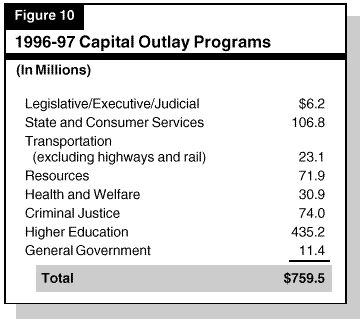
About 80 percent of the capital outlay budget is financed from general obligation bonds. The remaining funding is from the General Fund ($71 million), various special funds ($64 million), and federal funds ($9 million). Almost 60 percent of the total capital outlay funding is for the three segments of higher education and comes principally from bonds that were approved by the voters in March 1996.
Other Legislation. In addition to the Budget Act appropriations for capital outlay, the Legislature passed the following legislation authorizing $278 million in lease-payment bonds:
Assembly Bill 3499 provides for a 5 percent reduction in the bank and corporation tax rate (from 9.3 percent to 8.84 percent). The measure is in lieu of the Governor's proposal for a 15 percent across-the-board reduction in personal and corporation income tax rates. It applies to corporations with income years beginning on or after January 1, 1997, and will reduce revenues by $85 million in 1996-97, by $230 million in 1997-98, and by $290 million in 1998-99.
Senate Bill 38 includes several targeted tax-relief provisions as well as several revenue raising provisions which conform California tax law to federal tax law. Tax relief provisions include: (1) an increase in the research and development basic research credit and the university research credit, (2) an increase in the amount of business personal property purchased by small business that can be deducted in a single year (rather than depreciated over several years), and (3) a modification to the way in which foreign dividend deductions are computed.
Revenue-raising federal conformity provisions include: (1) limits on moving expense deductions, (2) a requirement that corporations compute their quarterly estimated payments based upon 100 percent of their prior year tax liability, and (3) a requirement that securities dealers value the securities held in their inventory based on current market prices (so-called "mark-to-market" provisions).
Overall, the net impact of SB 38 is a projected revenue reduction of $10 million in 1996-97, and a cumulative reduction of $80 million during the three-year period from 1996-97 though 1998-99.
Federal Internal Revenue Service Tax Offset Provision. The 1996-97 revenue forecast assumes that federal legislation will be enacted requiring the U.S. Internal Revenue Service to collect delinquent state taxes out of federal refunds owed to California taxpayers. (The state currently provides a similar service for the federal government.) This legislation would have increased state tax revenues by an estimated $85 million annually beginning in 1996-97. However, the federal legislation was not enacted before Congress adjourned.